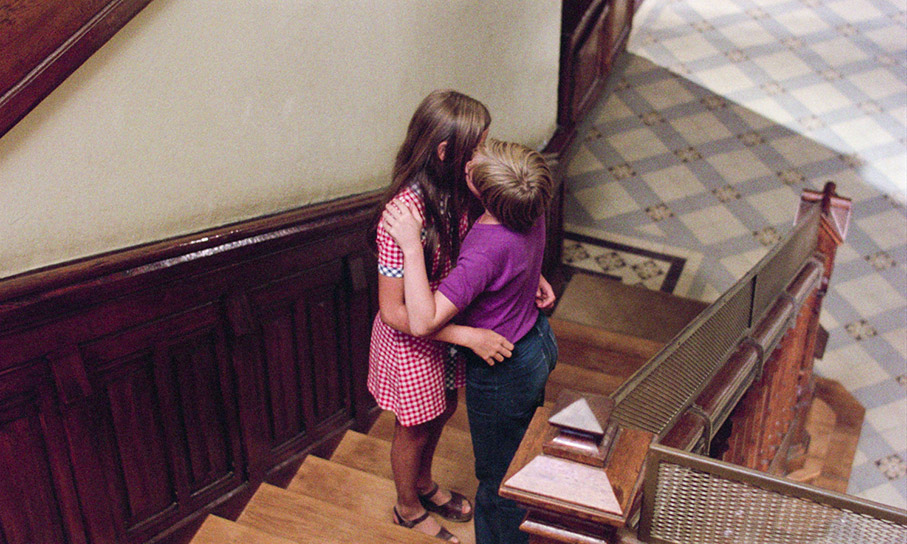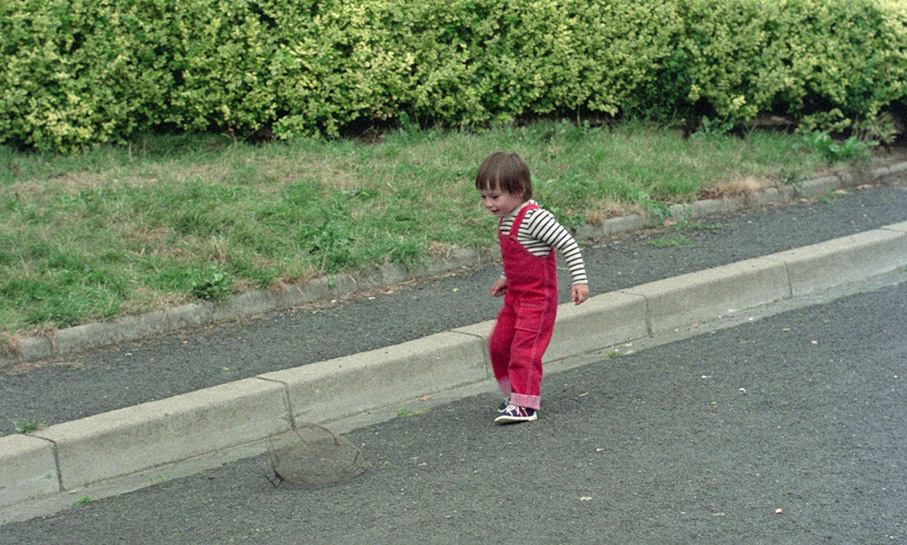Pocket Money
François Truffaut’s ode to childhood, POCKET MONEY [L’ARGENT DE POCHE], comes to Blu-ray from Radiance. Review by Gary Couzens.
To François Truffaut, it seems, children are the centre of the world. He begins Pocket Money (L’argent de poche, also known in English as Small Change) with a young girl, Martine (Pascale Bruchon), spending time with her father (a Truffaut cameo) in the village of Bruère-Allichamps, the geographical centre of France. She sends a postcard to her cousin in the small town of Thiers. His teacher Richet (Jean-François Stévenin) reads the card out in class. Pocket Money has no overall plot as such, just a series of incidents in the lives of a group of junior-school children, their parents and teachers. The incidents involve the experience of starting school and first love. Meanwhile, more troubled children cause problems. One child, Julien (Philippe Goldmann), a petty thief, is the most troubled of all, and the revelation of the cause of his behaviour ends the film on a darker note.
Truffaut made Pocket Money in 1975, completing it in 1976, just before starting work as an actor in Steven Spielberg’s Close Encounters of the Third Kind. In fact, Spielberg suggested the title Small Change, which was the one used on its cinema release in the USA and UK. Truffaut and his longtime assistant Suzanne Schiffman are credited with the script, but for the most part that was merely an outline and scene breakdown, and Truffaut developed the dialogue with his young cast. Childhood was a theme in Truffaut’s films from the beginning, with the short Les mistons (1957) and his first feature, The Four Hundred Blows (1959), which became one of the earliest films of what became known as the French New Wave (Nouvelle vague). That film was based on Truffaut’s own troubled childhood, and while not without humour, is utterly unsentimental. He returned to the theme in later work, such as The Wild Child (1970), just as unsentimentally.

While Pocket Money is an intended change of pace from Truffaut’s previous film, The Story of Adèle H. (1975), and stands in contrast to the more adult comedy of his next, The Man Who Loved Women (1977) and the darker Henry James-derived The Green Room (1978) which followed, by this point, something had changed in his work. You can see the same in his admirer and later director Spielberg, and it may be a function of age, being further removed from their own childhood. (Truffaut had been a father since 1959: his daughters Laura and Eva are both in the cast of Pocket Money, the former uncredited as such but listed as the assistant script supervisor.) It’s certainly the case that Pocket Money errs a little too far in the direction of sentimentality. It’s too intent on charming the audience into submission. The children’s language and behaviour aren’t sanitised but there’s a fine line between a realistic view of the young and asking us if often naughty kids aren’t cute. (Almost all boys, it has to be said, as the girls barely get a look-in. The school in the film is all-boys but we’re told will go co-ed next year.) Sometimes self-indulgence creeps in, such as a lengthy scene in a cinema where several of the cast watch a documentary about a child, later adult, who doesn’t learn to speak, communicating only in whistles. There are things to enjoy, not to mention an alarming episode where the youngest child in the film (billed as Little Grégory) follows a cat out on to an apartment balcony. Truffaut’s then-regular cinematographer, Nestor Almendros, wasn’t available, so DP duties went to Pierre-William Glenn (who had previously shot A Gorgeous Girl Like Me (1972) and Day for Night (1973) for the director). A more studied approach that Almendros might have had is less appropriate for this film, shot on location and having to work with many young children, and Glenn’s work is naturalistic and light on its feet.
Released in March 1976 and later that year playing in competition at the Berlin Film Festival, Pocket Money was one of Truffaut’s more commercially successful films in France, with 1.8 million admissions. In fact it was his third biggest hit in his home turf, with only The Four Hundred Blows and The Last Metro (1980) being bigger. It was Golden Globe-nominated for Best Foreign Film, losing to Ingmar Bergman’s Face to Face. The film was released in the UK on 16 June 1977. While the directors’ fans will certainly appreciate it more than most, Pocket Money is engaging but minor Truffaut.
sound and vision

Truffaut’s first three features, and the short Antoine et Colette, were shot in Scope, but with his next feature La peau douce (1964), he switched to the narrower 1.66:1 ratio and used that for all but one of two of his films for the rest of his career. That’s the case with Pocket Money, and the Blu-ray transfer is in the correct ratio. The colours aren’t the most vibrant, but that’s in keeping with Glenn’s cinematography, likely shot in natural light as Nestor Almendros would have done. Grain is natural and filmlike.
The sound is the original mono, rendered as LCPM 1.0, and it’s clear and well-balanced. English subtitles are on as default, but are optional. That’s also the case for the two French-language extras on the disc. I didn’t spot any errors, but there’s an odd and anachronistic translation in the on-set report: “film mosaïque” becoming “hyperlink film”.
special features
On-set footage (3:57)
A report from French television from 1975, presumably a film telerecording as it has splices and scratches and is in black and white when it would have been broadcast in colour. There is a brief interview with Truffaut and some of the young cast. One young boy shows himself well up on his director’s films, having seen not just The Four Hundred Blows but Stolen Kisses (1968) as well, the latter of which he wouldn’t have been old enough to see in the UK.
François Truffaut interview (29:40)
Truffaut is interviewed for Swiss television in December 1975, while Pocket Money was being edited. The (unnamed male) interviewer asks Truffaut the critic what he thought of Truffaut the film director, and the response is that after fifteen films he isn’t wholly satisfied, and might not be if he made fifteen more. As for his clear affinity with children, he says that he made his first feature at twenty-five, but felt he had more in common with his young cast than with adults, given that what other people would have devoted their lives to didn’t apply to him at that age because he had given his life to cinema. Also, while he preferred to vary the films he made, certain genres he felt he could make only the once, but there were many variations available for love stories, and certainly for films about children. Ultimately his films display his view that life is about being accepted, when so many of his characters are at least initially rejected. Truffaut discusses more “physical” films, such as those dealing with sexual love, and makes the odd comment (at least as subtitled) that he does not approve of nudity in films, even though he has included it in some of his, Pocket Money included. (Maybe he meant sex scenes, which it’s true he wasn’t best known for.)

The interviewer goes on to the technical aspects of his filmmaking. For Truffaut, editing is vital as it gives his films shape and lets them “sing”. He didn’t preplan camera movements as he prioritised the actors, especially given that most of his films were made on location rather than in studios. With Pocket Money, he didn’t write dialogue for his child characters as he thought adults couldn’t write authentically for children. Instead, he let the cast come up with their own, once he had established what was going on in each scene. This resulted in a lot of footage, at his estimate 50,000 metres for a final length of around 2000 (actually nearer 3000, but never mind). He also talks about his interest in acting, given that he first cast himself in one of his own films in The Wild Child, and it’s a pity that this interview took place before his best-known performance in someone else’s film, namely Close Encounters of the Third Kind. When he was a critic, he estimated that out of every ten films, eight were commercial and two aspired at least to be artistic, but (as of 1975) it was the other way round. Given that his foundations as a critic and cineaste were in American cinema, he’s surprisingly cool about what was coming from the USA at the time, which with hindsight seems a great era nowadays. He thinks the best American films come from those who migrated there (he names Roman Polanski, Miloš Forman and Ivan Passer). Fortunately for him, he is able to continue to make films, as long as he keeps below a certain budget level, of $1 million.
There’s something odd about this interview, at least on the review checkdisc I received. After twenty-six minutes, we cut to black and then we go to Truffaut being introduced by the interviewer, so what you’d expect to be at the start. That does allow the interviewer to conclude by mentioning Truffaut’s newest film, the one that’s on this disc.
Sonali Joshi interview (11:37)
Newly recorded for Radiance, curator Sonali Joshi talks about the first Truffaut film she ever saw, which she did as an adolescent. She addresses the themes of childhood in Truffaut’s work as far back as the beginning. Pocket Money was an intended lighthearted change of pace from the more sombre film that preceded it. She also talks about the father figures (less so mother figures) in the film, most of all Richet (Jean-François Stévenin), who does double duty as a father and a teacher, given a significant speech near the end, which is as close to “author message” as the film gets.
Theatrical trailer (1:33)
Trailer commentary (3:24)
Both of these items involve the US trailer, the film being distributed by Roger Corman’s New World Pictures under the Small Change title. It gets round the potential stumbling-block of subtitles by showing clips from the film with a voiceover. At first that’s Truffaut himself, speaking in English, before a female voiceover takes over extolling the director’s return to the subject of childhood, before Truffaut returns and hopes we enjoy the film.

Over to Allan Arkush in 2019, for Trailers from Hell. He was working for Corman at the time, working on the releases not just of exploitation films which played in drive-ins, but also the foreign-language films they distributed: Cries and Whispers, Amarcord and, relevant to the present film, The Story of Adèle H. When Truffaut visited, they took him to a hamburger joint nearby and asked him for anything he wanted. That turned out to be a showing of a 35mm print of Vertigo which somehow Joe Dante sourced, as the film was completely out of circulation at the time.
Booklet
This limited edition contains a booklet, which includes Truffaut’s written introduction to the film and a contemporary interview with him. This was not available for review.
final thoughts

Pocket Money
France 1976 | 104 mins
directed by: François Truffaut
written by: François Truffaut, Suzanne Schiffman
cast: Nicole Félix, Chantal Mercier, Jean-François Stevenin, Virginie Thévenet, Tania Torrens
distributor: Radiance
release date: 13 October 2025
Related reviews – director François Truffaut:
- The 400 Blows [Les quatres cents coups]
- Jules et Jim
- La peau douce
- Pocket Money [L’argent de poche]
- The Last Metro [Le dernier métro]
